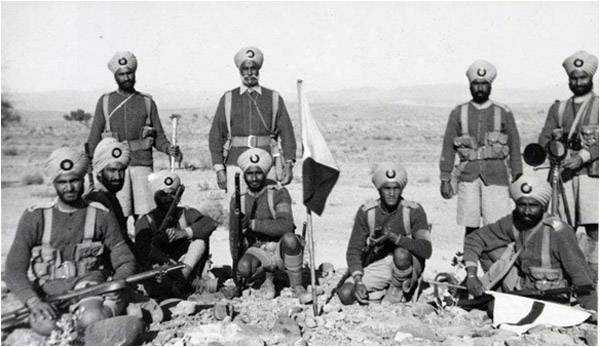
Soldiers of the A Company of the 2nd Royal Battalion, or Ludhiana Sikhs, pose for a photograph in Waziristan, where the 11th Sikh Regiment was sent in 1936 to fight against the Wazir leader Fakir of Ipi. They wear summer uniforms and carry Short Magazine Lee Enfield rifles. The photograph is part of a collection at the National Army Museum in London.
This was not the first time the Sikhs had been to Waziristan. The Sikh empire under Ranjit Singh began their forays into the northwest entering Bannu in 1819, but it was only after the fall of the Mughal and Durrani empires that they were able to make significant gains, conquering Peshawar in 1834. Ranjit Singh named a son born thereafter Peshaura Singh to commemorate the victory. The Sikhs attacked Waziristan in 1843 but were defeated. Despite their short rule, they left behind a large number of Sikhs in what is now the Khyber Pakhtunkhwa province and parts of the tribal areas of Pakistan.
Many however migrated to Afghanistan in 1947 to flee persecution in the newly formed Pakistan, and joined the Sikhs of Afghanistan. The Sikh community in Afghanistan consisted of converts from when the founder of Sikh faith Guru Nanak visited Kabul, traders who had set up colonies in the city, and those who had stayed behind from Sikh-Afghan and Anglo-Afghan wars.
Despite their persecution during the Mujahideen government and the Taliban rule and a mass exodus in the 1990, a small community of roughly 3,000 Sikhs still lives in Kabul.
This was not the first time the Sikhs had been to Waziristan. The Sikh empire under Ranjit Singh began their forays into the northwest entering Bannu in 1819, but it was only after the fall of the Mughal and Durrani empires that they were able to make significant gains, conquering Peshawar in 1834. Ranjit Singh named a son born thereafter Peshaura Singh to commemorate the victory. The Sikhs attacked Waziristan in 1843 but were defeated. Despite their short rule, they left behind a large number of Sikhs in what is now the Khyber Pakhtunkhwa province and parts of the tribal areas of Pakistan.
Many however migrated to Afghanistan in 1947 to flee persecution in the newly formed Pakistan, and joined the Sikhs of Afghanistan. The Sikh community in Afghanistan consisted of converts from when the founder of Sikh faith Guru Nanak visited Kabul, traders who had set up colonies in the city, and those who had stayed behind from Sikh-Afghan and Anglo-Afghan wars.
Despite their persecution during the Mujahideen government and the Taliban rule and a mass exodus in the 1990, a small community of roughly 3,000 Sikhs still lives in Kabul.

